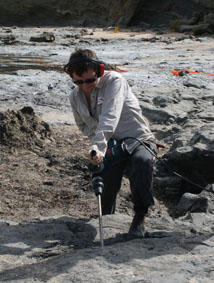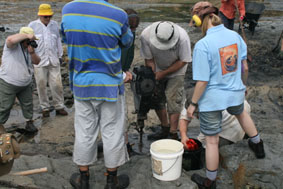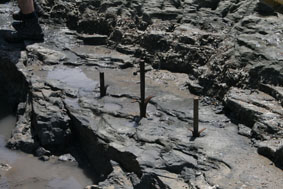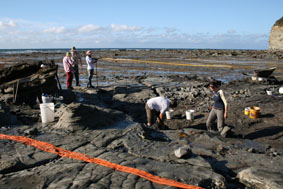| Monash home | About Monash | Faculties | Campuses | Contact Monash |
| Staff directory | A-Z index | Site map |
| Monash home | About Monash | Faculties | Campuses | Contact Monash |
| Staff directory | A-Z index | Site map |
|
Dinosaur DreamingResearch from the Monash University Palaeontology LaboratoryField techniquesOver the years, a variety of excavation techniques have been used at the Flat Rocks site near Inverloch. The site has always been problematic in some ways. Not because it's inaccessible - in fact the site can be reached very easily, and is now something of a tourist attraction - but because twice a day, on every high tide, the rock layer is inundated and covered by tonnes of sand. The 2009 field season focussed on an area called “Bridge-East”, which is the most easterly end of the fossil layer, closest to the sea. This area differs from the “Main” part of the fossil layer, further up the beach, in that the fossil layer is exposed vertically from top to bottom. This means that we can remove the fossil layer completely, without leaving the lowest layers behind, as we did in the Main area. This year we utilized an old excavation technique, which was used at Dinosaur Cove in the 1980’s, but had never been used at the Dinosaur Dreaming site. The technique is called “plug and feathering” and involves drilling a number of holes in the top surface of the fossil layer, in which sets of three metal rods are inserted. Two of the rods – the “feathers” – are semi-circular in cross-section at their base, which is wider than at the top. The tops of the feather are also curved outwards. When placed in the drill hole, the ends of the two feathers form a complete circle. The “plug” is like a long chisel, which is inserted between the two feathers and is hammered down between them using a sledge hammer or a special attachment on the end of the jack hammer. As the plug is hammered down between the feathers it forces them apart. A number of sets of plugs and feathers are placed approximately 50cms apart along the area to be excavated. The force of the plugs pushing on the feathers causes a crack to form between the sets and large blocks of rock can be separated from the fossil layer quickly and efficiently. Using this method we were able to excavate large blocks cleanly, with less crumbling of the fossil layer. At the end of the field season we carefully measured the excavation area and the data gathered will be used to map the area and provide us with information for future excavations.
 Drilling holes  Drilling more holes This year we utilized an old excavation technique, which was used at Dinosaur Cove in the 1980’s, but had never been used at the Dinosaur Dreaming site. The technique is called “plug and feathering” and involves drilling a number of holes in the top surface of the fossil layer, in which sets of three metal rods are inserted. Two of the rods – the “feathers” – are semi-circular in cross-section at their base, which is wider than at the top. The tops of the feather are also curved outwards. When placed in the drill hole, the ends of the two feathers form a complete circle. The “plug” is like a long chisel, which is inserted between the two feathers and is hammered down between them using a sledge hammer or a special attachment on the end of the jack hammer. As the plug is hammered down between the feathers it forces them apart. A number of sets of plugs and feathers are placed approximately 50cms apart along the area to be excavated. The force of the plugs pushing on the feathers causes a crack to form between the sets and large blocks of rock can be separated from the fossil layer quickly and efficiently. Using this method we were able to excavate large blocks cleanly, with less crumbling of the fossil layer.  Plugs and feathers  Crack opening between plugs and feathers  Crack getting larger At the end of the field season we carefully measured the excavation area and the data gathered will be used to map the area and provide us with information for future excavations.  Taking measurements  Marking boundaries  John and Gillian taking measurements  Measuring the excavation area |
|